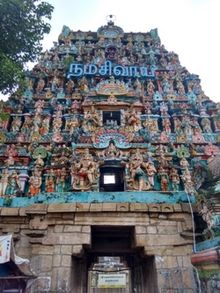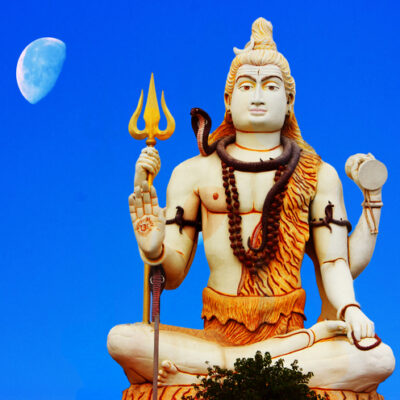Thiruvidimarathur Sri Mahalingeswarar Temple, Thanjavur

Address
Thiruvidimarathur Sri Mahalingeswarar Temple, Thiruvidimarathur Post Thiruvidimaruthur Circle Thanjavur District. PIN – 612104 PH:0435-2460660
Diety
Mahalingeswarar, Marudhavanswara, Marudhanaar Amman: Prahat Sutrangukambigai, Mahalanam
Introduction
Mahalingeswaraswamy Temple, Thiruvidaimarudur is dedicated to the deity Shiva, located in Tiruvidaimaruthur, a village in the South Indian state of Tamil Nadu. It is significant to the Hindu sect of Saivism as one of the seven major Shiva temples. Shiva is worshiped as Mahalingeswaraswamy, and is represented by the lingam, with his idol referred to as Jothimayalingam. His consort Mookambika is depicted as Pirguchuntarakujambigai. The lingam of the temple is believed to be the focal point for the seven consorts of Shiva. The presiding deity is revered in the 7th century Tamil Saiva canonical work, the Tevaram, written by Tamil poet saints known as the nayanars and classified as Paadal Petra Sthalam. The 9th century Saiva saint poet Manikkavacakar has sung praise about the temple in his works.
Puranic Significance
There are 149 inscriptions associated with the temple indicating contributions from Pandyas, Cholas, Thanjavur Nayaks and Thanjavur Maratha kingdom. The oldest parts of the present masonry structure were built during the Chola dynasty in the 9th century, while later expansions, including the towering gopuram gatehouses, are attributed to later periods, up to the Thanjavur Nayaks during the 16th century. The name “Kumbakonam”, roughly translated in English as the “Jug’s Corner”,is believed to be an allusion to the mythical pot (kumbha) of the Hindu god Brahma that contained the seed of all living beings on earth. The kumbha is believed to have been displaced by a pralaya (dissolution of the universe) and ultimately came to rest at the spot where the town of Kumbakonam now stands.The drops of nectar are believed to have fallen onto five shrines around Kumbakonam, namely Mahalingeswarar temple at Tiruvidaimarudur, Tirudharasuram, Naganathar Temple at Tirunageswaram, Tiruvorgam and Tirupadalavanam. The legend of a Chola prince who killed a Brahmin and was in turn, pursued by his spirit (Brahmarakshas), is associated with the temple. The Chola prince, it is believed, entered the Mahalingeswarar Temple and prayed to his favourite God, Shiva for relief from the clutches of the spirit of the dead Brahmin or brahmarakshas. The Chola prince made his way out through another entrance thereby saving himself. Some sources associate the legend with Pandya king Varagunapandian. It continues till day where people take the second entrance to exit the premises after worship. There is a sculpture of Chola brahmaharakshas on the eastern premises in one of the inner gopurams (tower gateway). Shiva is believed to have appeared as a flame to please Agastya and other sages who were performing penance. Shiva (Rudra) is said to have emanated from the heart of Mookambika. It is also believed that several other deities like Vinayaga, Murugan, Parvathi, Kali, Lakshmi, Saraswathi, Brahma, Airavata (the elephant of celestial king Indra) and Vishnu worshipped Mahalingaswamy.
Special Features
The temple has a five-tiered Rajagopuram and three precincts, each enclosed inside huge walls and having gateway towers for each of them.The temple is rectangular in plan with east–west orientation and has four entrances in each of the four directions. Mahalingam, literally meaning big lingam, is the presiding deity and is considered the centre of all consort deities of Tamil Nadu. There are five temple tanks inside the temple, namely Karunyamirdha Theertham, Soma Theertham, Kanaga Theertham, Kalyana Theertham and Iravatha Theertham. There are 27 other water bodies that are associated with the temple. There is a separate shrine for Mookambiga and it is built in north Indian style. The shrine of Mookambiga is where Parvathi is believed to have performed her penance.There are stone images of Pattinathar and Bhadragiriyar in the eastern and western gateways of the temple respectively. The central shrine of the temple is that of Mahalingaswamy facing East. The shrine of Ambal faces the east and is situated close to the Mookambigai Amman shrine.The temple was widely expanded during the Nayak period in the 16th century with the development of twin Mahalinga and Devi shrines.The shrines of Muruga and Nataraja are enshrined in the spaces between the pier. There are other shrines for Padithurai Vinayagar and Agora Veerabadrar. The three precincts are called Aswametha Pradakshina, Kodumudi and Pranava. The Vinayagar in the Southern side is called Anda Vinayagar and as per Hindu legend, the Vinayagar ruled the world and hence obtained the name. Pranava precinct has lot of sculptures dating back to the Nayak period of the 16th century. One of the notable among them is the sculpture of a chariot having twelve pillars, each denoting the twelve lagnas. In the northern portion of Kodumudi precinct, there is an image of Chokkanathar.
Festivals
The temple priests perform the pooja (rituals) during festivals and on a daily basis. Like other Shiva temples of Tamil Nadu, the priests belong to the Shaivaite community, a Brahmin sub-caste. The temple rituals are performed six times a day; Ushathkalam at 6:00 a.m., Kalasanthi at 8:00 a.m., Uchikalam at 12:00 p.m., Sayarakshai at 6:00 p.m., Irandamkalam at 8:00 p.m. and Ardha Jamam at 9:00 p.m. Each ritual comprises four steps: abhisheka (sacred bath), alangaram (decoration), neivethanam (food offering) and deepa aradanai (waving of lamps) for both Mahalingeswarar and Pirguchuntaragujambigai. The worship is held amidst music with nagaswaram (pipe instrument) and tavil (percussion instrument), religious instructions in the Vedas read by priests and prostration by worshippers in front of the temple mast. There are weekly rituals like somavaram and sukravaram, fortnightly rituals like pradosham and monthly festivals like amavasai (new moon day), kiruthigai, pournami (full moon day) and sathurthi. The most prominent festival of the temple, Thaipoosam, is celebrated for ten days during the Tamil month of Thai. The festival deity of Mahalingeswarar and his consort circumambulate the temple and the streets in the village in different vehicles. The festival ends with Theerthavari on the last day. During the Tamil month of Vaikasi, Tirukalyanam (sacred marriage), Ambal Tapasu (penance of Ambal), Ambal Thannai thaane festivals are celebrated.
Century/Period/Age
1000 to 2000 years old
Managed By
Hindu Religious and Charitable Endowments (HRCE)
Nearest Bus Station
Thiruvidimarathur
Nearest Railway Station
Kumbakonam
Nearest Airport
Trichy









